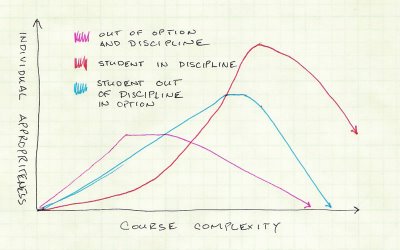The curricular revisions continue at work. We've got a couple of fairly interesting conundrums to solve. Mostly decisions about who should take what when, and what should be included within courses that everyone takes. Students and faculty all have different goals and priorities and yet we are charged with coming up with something coherent.
It's gotten difficult to describe the issues in uncharged terms. Its real hard to talk about what should be included without making one population or another feel like they aren't important. The other day, while trying to find a benign way to represent some of the issues I scribbled this on a notepad: Sometimes I feel like this revision ought to be getting all of us a PhD in Education. What I am trying to depict here graphically, and hopefully apolitically, is the relative usefulness of a course in a specific discipline to varied populations within the student body based on how complicated the material is that is being presented.
Sometimes I feel like this revision ought to be getting all of us a PhD in Education. What I am trying to depict here graphically, and hopefully apolitically, is the relative usefulness of a course in a specific discipline to varied populations within the student body based on how complicated the material is that is being presented.
One of the interesting things theorized here is that a course doesn't really even become interesting to the group invested in the specific information until just about it becomes too much for the population out of their element. Of everything on the chart, this is the phenomenon I have seen played out in classrooms.
I'm fairly confident about the shape of the curves on the increasing side of the maximum. It would be interesting to know more about the size of the plateau and the slope of the decline.
Basically this is a graphical way to say that a course can't be all things to all people. I hope to use this type of reasoning to help determine what level course content ought to be aimed, and then once we have that level to understand who will, and who will not benefit from the class. Ideally this will help to lead into some compromises regarding common content and total individual curricular depth.
Or maybe its just a picture with pretty colors.
Saturday, February 18, 2006
All Things To All People
Posted by
David
at
12:08 AM
![]()
Subscribe to:
Post Comments (Atom)


3 comments:
I'm not sure if there's a way to say this w/o it coming across as strange, but have you considered the increase in educational value to a student from within a course's discipline when they get to teach or help students who have never before encountered the subject matter? Sometimes you reach a point as a student when it feels like class lectures or fake homework just aren't helping you right now. But explaining it to someone who asks questions forces you to think about a subject from the bottom up, often changing the way you think about it. It just occured to me, by the way, that I probably don't need to explain this to someone who tecahes all the time. But it does help compensate for the low points on the magenta arrow.
Often I think we consider the idea that an advanced student in a group can find some challenge in assisting students that aren't progressing as quickly. I think I depend on that in my CAD class.
I would think that it is a topic for debate how well spent that time is for the advanced student. It feels like a lemonade solution.
But then, the guts of the thing is that at some point there will have to be some sort of compromise.
Alternately you have to consider the scenario where the disparity in the value isn't an "over their head" thing, but truthfully something that doesn't get them closer to their goal. Different causes, different ramifications.
In all of this discussion, don't forget the first year of production electrics... we had Lighting Designers, TDs and Production Managers, and the "middle ground" ended up being over the heads/beyond the interest of the TD/PM population and ridiculously elementary to the LD population. I imagine that the class has improved greatly and people don't hate it, because its a good idea in concept, and I wish that I had made a greater effort to learn the concepts, but it will always stand out in my mind as an example of trying to please too many masters.
Forgive me if this is an impolite comment, its still early =D
Post a Comment